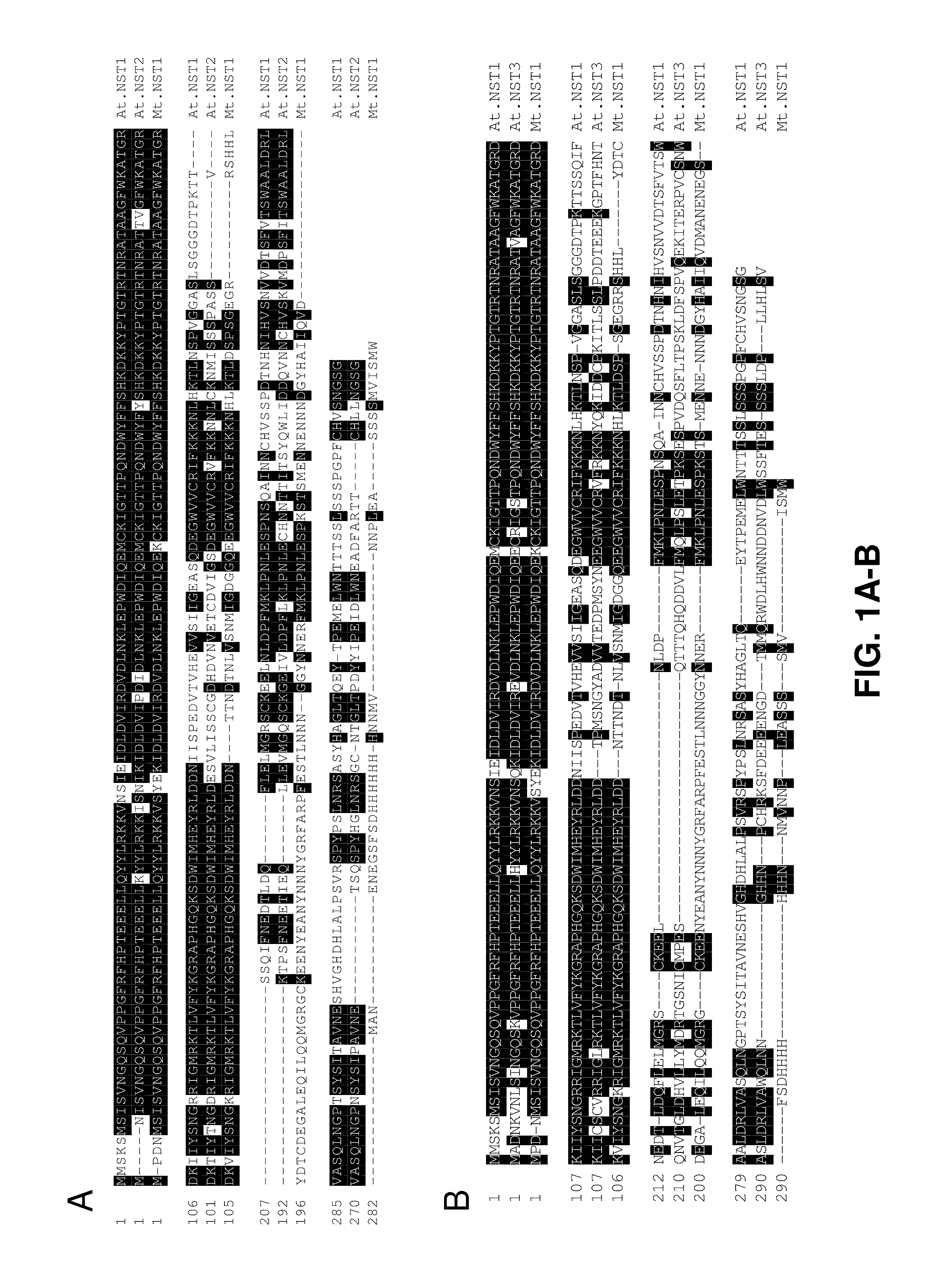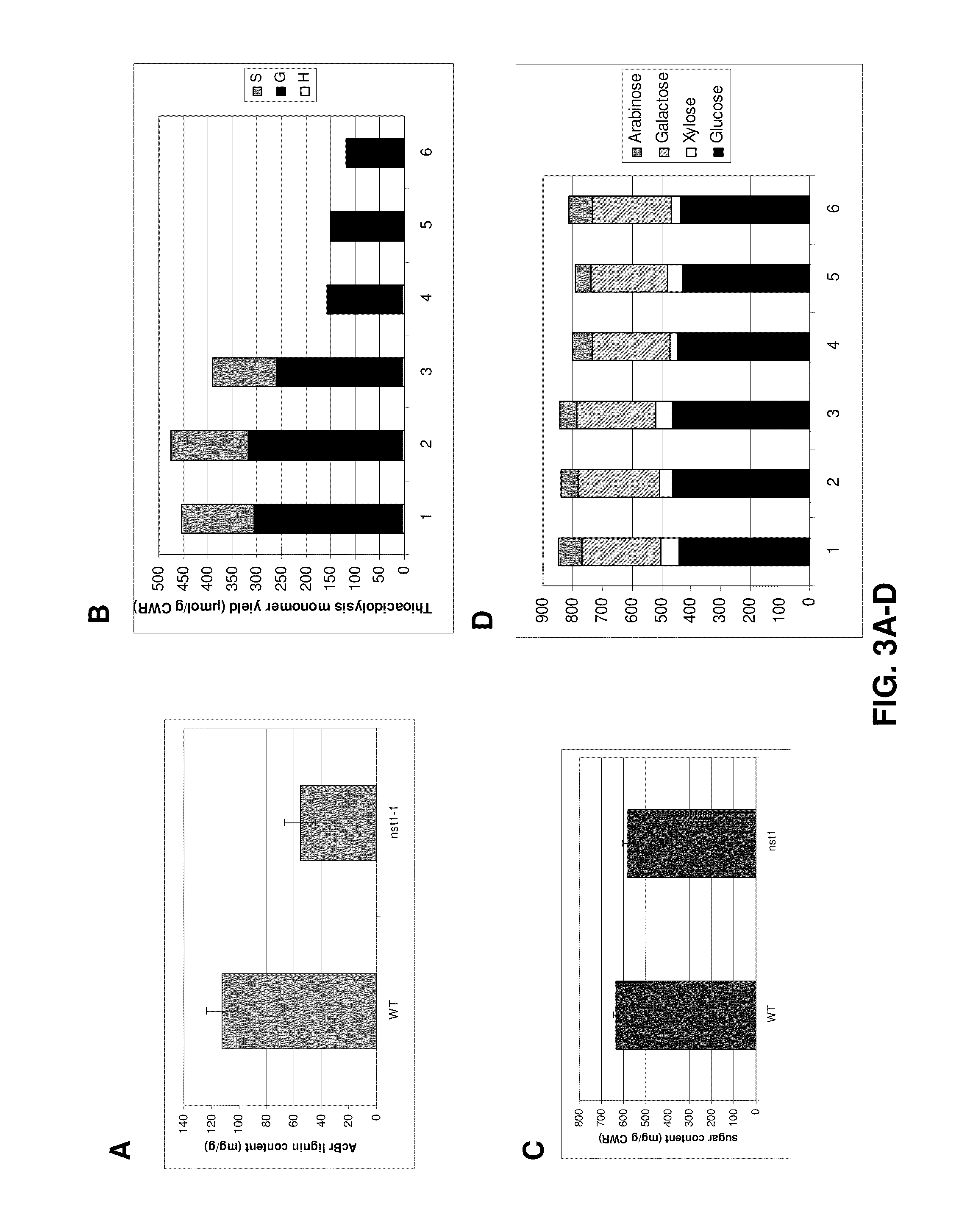Plants with modified lignin content and methods for production thereof
a technology of plant lignin and lignin content, applied in the field of genetically modified plants, can solve the problems of reducing the efficiency of cellulose enzymatic hydrolysis, consuming energy, and reducing the energy conversion efficiency of lignocellulosic biomass, so as to increase the digestibility of forage crops and reduce lignin content. , the effect of enhancing the digestibility
- Summary
- Abstract
- Description
- Claims
- Application Information
AI Technical Summary
Benefits of technology
Problems solved by technology
Method used
Image
Examples
example 1
Isolation and Characterization of M. truncatula NST1 Mutants
[0170]To identify mutants with defects in secondary cell wall formation, a R1 population of tobacco Tnt1 retrotransposon insertion-mutagenized M. truncatula (see, e.g., Tadege et al., 2005; Tadege et al., 2008) was screened by UV microscopy of cross-sections of the 6th internodes of stems. Plants were grown in MetroMix 350 soil mix at 24° C. day / 20° C. night temperature, 16 h day / 8 h night photoperiod, 70-80% relative humidity, and 150 μmol / m2 / s light intensity. Sixth internodes of each plant were harvested when the plants had reached around eight internodes, and were stored at −80° C. Cross section of Medicago stems (100 μm) from the sixth internode from the top were cut with a Leica RM 2255 microtome. The micrographs were taken under a Nikon Micophot-FX system with a Nikon DXM 1200 color camera. Four nst1 alleles were identified from screening of a segregating population of approximately 9,000 independent R1 lines.
[0171]A...
example 2
Additional Phenotypes of M. truncatula NST1 Mutants
[0176]At first sight, the overall growth phenotypes of the four independent nst1 mutant lines appeared similar to those of wild-type plants, although the branches were less able to support themselves against gravity, presumably due to the defect in secondary wall formation. Vegetative growth was not strongly affected in the Mt-NST1 mutant lines, but stem length was reduced by around 25% and leaf area increased by around 14% (Table 2). The reduction in stem length was mainly the result of reduction of internode length in the last 3 internodes below the flowering node. Flowering time and stem diameter were not affected in the mutant lines (Table 2).
TABLE 2Characterization of control (Wt 1-3) and MtNST (Mtr-nst1 / 1-3) mutant lines.InternodesStemlengthLeafStemPhotosyntheticTranspirationheightFloweringmediaareadiameterraterateStomataLine(cm)Node(cm)(mm2)(mm)(μmolCO2 · m−2 · s−1)(μmolH2O · m−2 · s−1)apertureWt170.4 ± 0.511.5 ± 0.65.9 ± 0.5...
example 3
Cell Wall Composition of Mtnst1 Mutants
[0179]The total lignin content of stem internodes 5-8, as determined by the acetyl bromide method (Fukushima and Hatfield, 2004) using ˜15 mg extractive-free material (Hatfield et al., 1999). The same molar extinction coefficient of 17.2 (as determined for lignin from wild-type alfalfa) was used for samples for all the transgenic lines. Thioacidolysis methods were used for the determination of lignin composition. Thioacidolysis was performed using ˜20 mg of extractive-free samples reacted with 3 ml of 0.2 M BF3 etherate in an 8.75:1 dioxane / ethanethiol mixture. Lignin-derived monomers were identified by gas chromatography mass spectrometry (GC / MS) and quantified by GC as their trimethylsilyl derivatives, as described previously (Lapierre et al., 1995).
[0180]Results of these studies demonstrated that lignin content was reduced by around 50% in the MtNST1 mutant compared with wild-type plants (FIG. 3A). Extractable lignin monomer yields were meas...
PUM
| Property | Measurement | Unit |
|---|---|---|
| size | aaaaa | aaaaa |
| size | aaaaa | aaaaa |
| pressures | aaaaa | aaaaa |
Abstract
Description
Claims
Application Information
 Login to View More
Login to View More - R&D
- Intellectual Property
- Life Sciences
- Materials
- Tech Scout
- Unparalleled Data Quality
- Higher Quality Content
- 60% Fewer Hallucinations
Browse by: Latest US Patents, China's latest patents, Technical Efficacy Thesaurus, Application Domain, Technology Topic, Popular Technical Reports.
© 2025 PatSnap. All rights reserved.Legal|Privacy policy|Modern Slavery Act Transparency Statement|Sitemap|About US| Contact US: help@patsnap.com



